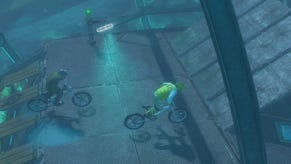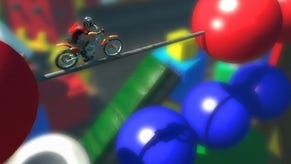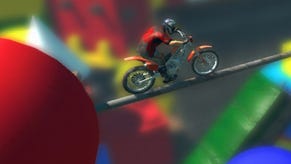Tech Analysis: Trials Evolution
Excite bike.
Just over two and a half years ago, RedLynx released Trials HD on Xbox Live Arcade. Not only was it a brilliant game, it was a rare example of a 360 exclusive designed from the ground up to make the most of the console's unique architecture. Lead programmer Sebastian Aaltonen, one of the most gifted engine coders working on the Xbox platform, helped to define a game that was not only rampantly playable but also looked quite unlike anything else on the console: beautiful physics combined with pixel-perfect dynamic lighting, shadowing and material effects to produce a game that remains an stunning technical achievement to this day.
Now we have Trials Evolution - a sequel that manages to better the original in almost every way. Everything that defined Trials HD has been retained or improved, and the list of new features and technological accomplishments in the new game is very exciting indeed. But first, let's refresh ourselves on just how good the original game was before we move onto the improvements, revisions and milestones achieved in the sequel.
The 60Hz performance of the Trials series is a defining element in the gameplay: the fastest possible update makes for a rock-solid response from the controls, gives the player the most feedback from the terrain and lends the physics engine in general a much higher level of fidelity. Here's a compendium of highlights from the first game, using leaderboard replays provided by EGTV video mastermind, James Hills - possibly the most obsessed Trials addict on the team.
Somehow, providing footage at the internet standard 30 frames per second comes across as something of a disservice to a game like this, so all of our video embeds are running at a full-on 60FPS. We recommend switching to full-screen mode in order to get the smoothest playback owing to Adobe's sub-optimal rendering. Alternatively, check out the site on an iPad or comparable device for best-in-class hardware-accelerated video performance on this and all videos served from Eurogamer.
"The original Trials HD remains one of the most technically impressive games on 360, but the new sequel exceeds and improves on it in almost every way."
With Trials HD, RedLynx maintains 60 frames per second admirably throughout, with just the odd dropped frame - literally just one or two across a sampling here of over 25,000 and unnoticeable to the human eye. However, in addition to that we do see one major performance hiccup: at around the 1:30 mark, an end-level event sees multiple explosions ignite, with a range of transparency effects clearly giving the Xbox 360's graphics core some issues. There's no tearing in Trials HD though - RedLynx kept v-sync engaged, meaning that the vast majority of all frames rendered were complete in under 16.67ms.
The original Trials also runs with no anti-aliasing and is bordered top and bottom in order to fit the framebuffer and render targets into the 10MB of ultra-fast eDRAM connected directly to the Xenos GPU. This is in contrast to the sequel which restores a full screen look and also utilises post-processing anti-aliasing (it looks like an implementation of NVIDIA's FXAA). Trials HD's lighting and low contrast artwork made aliasing far less of an issue than it might have been, but the shift to the outdoors make some kind of AA technology somewhat essential and FXAA would be the best fit here. However, as the FXAA code is open source, RedLynx would have been free to adapt it however they pleased.
How screen refresh is handled in Trials Evolution also sees a key difference: with so many new technologies in the place, there is the danger of rendering occasionally running over budget, so RedLynx shifts away for a locked vertical sync to an adaptive strategy. If render time is under 16.67ms, the game waits for the next vertical refresh and the next frame is displayed with no tearing. If the frame isn't complete by then, the framebuffer is flipped while the screen is updating, resulting in screen-tear. Curiously, the review code sent out in advance of the final game was prone to some quite severe examples of this in places, but it's really not an issue in the complete version you'll download from Live, manifesting mostly in the form of a "judder" fleetingly seen at the top of the screen.
Clearly a lot of optimisation has been done since the review version was released to journalists. To illustrate, here's a collection of scenes from Trials Evolution that centres on the game's generous use of alpha transparencies - which should in theory cause the 360's Xenos GPU some real difficulties. RedLynx uses alpha not just for fire and smoke, but also for particles, water splash effects and also for atmospheric rendering on the game's larger, more expansive environments. We see the odd evidence of torn frames here, but the effect is localised mostly at the top of the screen and isn't really noticeable. This video in itself is an excellent example of how RedLynx has crafted some levels to take advantage of the core strengths of the new engine - these stages are a real showcase for the spectacular effects work possible.
"RedLynx uses alpha not just for fire and smoke, but also for particles, water splash effects and also for atmospheric rendering on the game's larger, more expansive environments."
Over and above the sheer spectacle, Trials has also got a whole lot bigger too, and not just in terms of a level count that has almost doubled over the first game. The dark interior warehouse environments of Trials HD have been given the elbow in favour of a new approach that sees the gameplay shift outdoors, with field of view adjusted to show more of the upcoming terrain to the player. This makes the game less a test of memory and more a test of skill, giving us more time to adapt speed and rider positioning for the obstacles ahead.
The change in environment revolutionises the look of the game in many crucial ways. First of all, the limited set of level building blocks has given way to a much more varied look. We see a vast range of available materials - dirt, rock, tarmac and many more - all of which have a slightly different level of friction on the wheels of the bike, mixing up the gameplay. The shift to the outdoors has also seen RedLynx introduce other effects new to the Trials games - an accomplished-looking water effect (animated with geometry) is all-new, and is lit perfectly according to the established light sources in the scene. It's just one example of an effect that is typically rather expensive to process that makes its way into Trials Evolution without any noticeable hit to the 60 frames per second update.
Also noteworthy is the fact that while Trials Evolution retains the 2D plane for hosting gameplay, the action takes place in a full 3D environment featuring a terrific amount of scale and depth. Many games achieve some impressive vistas by combining 3D rendered visuals with 2D backgrounds or skyboxes (Final Fantasy 13 being one example), but Trials Evolution is remarkable in that it renders entire 3D worlds in which the 2D gameplay takes place: fall off a structure at the top of a mountain and you can witness the rider plummets towards the earth, revealing fully rendered areas of the level you can't access during general gameplay but get the full 3D treatment nonetheless.
"While Trials Evolution retains the 2D plane for hosting gameplay, the action takes place in a full 3D environment featuring a terrific amount of scale and depth with an increased field of view."
It may seem like a bit of a missed opportunity to transplant Trials' existing 2D gameplay into a full 3D world, but the game does make some use of the additional dimension by allowing for the creation of circuits that twist and turn into the scenery, so RedLynx has the option of conjuring up noteworthy landmarks in its expansive environments and then running gameplay around them in three dimensions.
The vast increase in level variety also sees RedLynx's brilliant lighting technology get much more of a workout in the new game. Different lighting schemes help define the look of each level, from the Medal of Honor inspired beachhead stage to circuits set across several times of day with varying weather conditions (including lightning, which provides a remarkable illumination effect across the whole terrain). However, it's on the limited amount of indoor scenes that we get to see the real-time lighting technology at its best: utilising multiple light-sources in enclosed areas gives us the most impactful examples of how the engine creates so many dynamic shadows - a noteworthy achievement at 60Hz.
However, at times it appears that refresh rate on dynamic shadows varies - presumably in order to help maintain the all-important frame-rate - while resolution also doesn't seem to be as high as it was in the original Trials HD, particularly on the bike's shadow. Bearing in mind the wealth of new technologies RedLynx has introduced for Trials Evolution, this is understandable, and as you can see in the video below, the compromises are well worth it for the quality of the overall effect and the increase in variety we see between stages.
"Support for both indoor and outdoor environments in Trials Evolution ensures that RedLynx's revised real-time lighting and shadowing technology gets an exhaustive workout."
Listed among many of its almost unbelievable technical achievements was the way in which the original Trials HD compressed level data into just 8KB (yes, 8192 bytes). Obviously that would have increased somewhat in the new game, but Trials Evolution retains its fast loading times for each level regardless of how large they are owing to the centrepiece tech that makes these expansive environments possible: virtual texturing.
Of course, we've seen this technology in action before. In fact, it's the centrepiece of id software's impressive Rage, allowing for immensely detailed environments running at a super-smooth 60 frames per second. The basic idea is that the entire area is stored on hard drive in the form of an immense single texture, areas of which are "clipped" out and rendered on-screen. A level requiring multiple gigabytes of RAM can then be streamed according to the viewing requirements of the current frame, saving enormous amounts of memory and offering some significant performance advantages.
There's perhaps no better example of the virtual texturing technology at work than in the Gigatrack stage, which rounds off the medium difficulty level courses. It's the longest circuit ever created by RedLynx for a Trials game, taking around seven minutes to complete for an expert (and considerably longer for those with lower skill levels), and sees the player travelling through a sparsely populated, undulating terrain, through a trainyard, past an industrial area, onto the train tracks then into the mountains, through a logging plant before a final ascent to the pinnacle of the map. By this time, you'll also have noticed that lighting conditions have changed - progress across the course is mapped by subtle changes in the time of day, with the level ending at dusk.
"RedLynx has utilised virtual texturing technology similar to id software's Rage to bring full 3D environments to Trials Evolution while maintaining the signature 60Hz frame-rate."
There are disadvantages with this technology, of course - and Rage does a good job of showcasing them rather well. Sharp, scene-shifting movements can result in noticeable texture pop-in, the speed of which is highly dependent on the speed of the storage the data is streamed from: Rage installed to HDD works much more smoothly than running the game from DVD, and on PS3 there are significant gains to be had from running the game on SSD compared to a conventional hard drive.
However, it can be argued that most of the negative points of virtual texturing don't apply to a game like Trials Evolution. Indeed, the tech is an almost perfect fit. There's no first person viewpoint in Trials, and the player is typically only ever moving in just one direction, plus the developers will be perfectly aware of the maximum speed in which the biker can traverse the level. This means that all the caching required can be achieved ahead of time, all but eliminating the ugly pop-in we saw in Rage. The only time we see the illusion compromised is when the player is reset to an earlier stage in the level, or when the scene changes completely - for example in end-level sequences.
However, even in this regard Trials Evolution has an advantage. Being an Xbox Live Arcade game, it doesn't have to contend with the slow seek times of an optical disc and can instead take advantage of the hard drive or USB flash media, so while the texture pop-in is noticeable on cuts from scene to scene or with mid-race checkpoint resets, it's potentially less of an issue than it might have been for a traditional retail game.
Overall, Trials Evolution works beautifully in that it's an excellent example of advanced rendering and processing technology working to produce not just standards-setting visuals for their own sake, but in service of a superb gameplay experience. It retains and enhances the brilliant playability of the original, and builds upon it. Other crowd-pleasing elements include support for simultaneous four-player racing (four times the load on Trials' state-of-the-art physics tech then - impressive) plus a revamp of the track editor that should bring LittleBigPlanet levels of customisation to RedLynx's classic in the making. All this and more will be discussed with lead programmer Sebastian Aaltnonen in a tech interview coming to Digital Foundry soon...









